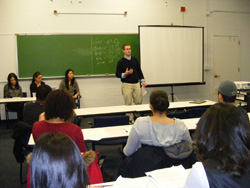Diversity on Display
Students tackle issues of race and ethnicity in higher education at TC conference
For all intents and purposes, Lauren Moon works in a two-person office at Columbia University
“I am consistently being reinforced of my value because students will gravitate to me,” said Wood, who is white, “over my black co-worker despite the fact that her desk is much more visible than mine and she’s 28 years older than me.”
So it was at the third annual Student Diversity Mini-Conference on December 16, where students in Professor Pamela Felder Thompson’s Theories of Diversity in Higher Education course presented their culminating projects to a room full of students and guests. The event, which was held over two successive Tuesdays to accommodate four group presentations, was sponsored by the Higher and Postsecondary Education Program and the Office of Diversity and Community Affairs.
“Diversity is such an important issue and the conference is an opportunity to make it more visible to the wider community here at Teachers College,” said Janice Robinson, Vice President for Diversity and Community Affairs. “It’s great that people could come and engage with and think about these issues—that’s why my office sponsors it.”
For Thompson, the goal is not for students to find answers to what are often intractable problems that extend well beyond the ivory tower, but to have them engage with issues of race, ethnicity and class—and do it in public forum.
“One of the biggest critiques of the institution is that diversity is not a respected field of research,” Thompson said. “So what I like to do is have this conference lend credibility to the fact that diversity research in higher education is a viable, burgeoning field and, therefore, it’s essential that students understand that diversity is one of the most critical issues in higher education.”
It was a message that came through loud and clear to student Vivian Chen. The often frank discussions with her classmates and her own dawning realization that the vexing issues of inequality and race persist despite even the best of intentions were for her one of the course’s most lasting lessons.
“I know we’re not anywhere near equality, but I guess I was a little naïve in thinking that we were a little farther ahead than we are,” she said. “There’s a lot of work to do and given that it’s 2008, that realization can be really frustrating. I think there was consensus about that.”
Published Tuesday, Mar. 10, 2009
